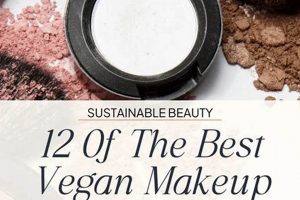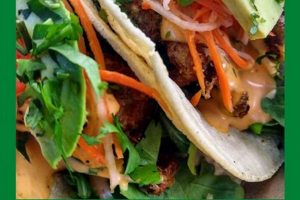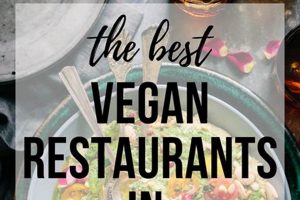Hydrating and protecting the delicate skin of the lips is essential, and numerous products exist to serve this purpose. A specific category of such products excludes animal-derived ingredients and prioritizes plant-based or synthetic alternatives. These formulations avoid substances like beeswax, lanolin, and honey, focusing instead on components such as shea butter, cocoa butter, candelilla wax, and plant oils. An example might be a balm containing shea butter, coconut oil, and vitamin E, designed to moisturize and soothe chapped lips while adhering to vegan principles.
The increasing awareness of animal welfare and environmental concerns has fueled the demand for cosmetics and personal care items that align with ethical and sustainable practices. Formulations devoid of animal products cater to a growing segment of the population seeking cruelty-free options. Beyond ethical considerations, such alternatives may offer benefits like reduced allergic reactions for individuals sensitive to animal-derived ingredients. Historically, the use of animal products was commonplace in cosmetics, but the shift towards plant-based alternatives represents a significant evolution in the industry.
The subsequent sections will delve into the specific ingredients commonly found in these formulations, the criteria for evaluating their effectiveness, and the various brands that offer compelling options in this product category. Additionally, factors such as ingredient sourcing, packaging sustainability, and overall value will be examined to provide a comprehensive understanding.
Guidance on Selecting Effective Plant-Based Lip Care
Selecting a lip care product free from animal-derived ingredients requires careful consideration of various factors to ensure both efficacy and alignment with personal values. The following guidance aims to provide clarity in navigating the available options.
Tip 1: Ingredient List Scrutiny: Thoroughly review the ingredient list to confirm the absence of beeswax (cera alba), lanolin, honey (mel), and carmine. Seek out products that explicitly state “vegan” on their packaging.
Tip 2: Emollient Selection: Prioritize formulations containing plant-based emollients such as shea butter, cocoa butter, coconut oil, jojoba oil, and avocado oil. These ingredients provide effective moisturization and create a protective barrier against environmental factors.
Tip 3: Humectant Inclusion: Look for products containing humectants like glycerin or hyaluronic acid. These ingredients attract moisture from the air, helping to keep lips hydrated.
Tip 4: Sun Protection Factor (SPF): For daytime use, select a product with a broad-spectrum SPF of at least 15. This will protect the lips from harmful ultraviolet radiation, preventing sun damage and premature aging.
Tip 5: Unscented Considerations: Individuals with sensitive skin should opt for unscented formulations, as added fragrances can sometimes cause irritation or allergic reactions.
Tip 6: Ethical Sourcing Verification: Investigate the brand’s sourcing practices to ensure that ingredients are obtained ethically and sustainably. Look for certifications such as Fair Trade.
Tip 7: Packaging Evaluation: Consider the environmental impact of the packaging. Opt for products packaged in recyclable or biodegradable materials to minimize waste.
Adhering to these guidelines can greatly improve the selection process. Prioritizing plant-based ingredients, verifying ethical sourcing, and considering individual sensitivities all contribute to a well-informed purchase.
The concluding section will address specific brands and product recommendations based on the aforementioned criteria, providing actionable information for consumers seeking to make responsible choices.
1. Hydration Duration
Hydration duration is a crucial determinant of the efficacy and overall value of any lip care product, particularly within the segment of plant-based formulations. The primary function of a lip balm is to alleviate and prevent dryness, chapping, and discomfort. A product’s ability to maintain hydration over an extended period directly influences its perceived effectiveness and consumer satisfaction.
- Occlusive Barrier Integrity
The persistence of the occlusive barrier created by a plant-based lip balm directly impacts hydration duration. Ingredients such as shea butter, cocoa butter, and candelilla wax form a protective layer that reduces transepidermal water loss (TEWL). A well-formulated product maintains this barrier despite exposure to environmental factors like wind, cold, and saliva. The failure of this barrier leads to rapid moisture evaporation, negating the balm’s intended benefits. For instance, a lip balm containing a high percentage of volatile oils may initially feel moisturizing but provide limited long-term hydration compared to one rich in stable, occlusive lipids.
- Humectant Efficacy and Longevity
Humectants, such as glycerin and hyaluronic acid, attract moisture from the atmosphere to the skin. Their effectiveness in a lip balm is contingent upon their concentration and interaction with other ingredients. A formulation that effectively binds humectants within the stratum corneum enhances hydration duration. Conversely, a product with poorly incorporated humectants may result in a temporary plumping effect followed by increased dryness as the humectants draw moisture from deeper skin layers without adequate replenishment. The inclusion of emollients alongside humectants is crucial for sealing in the attracted moisture, contributing to sustained hydration.
- Ingredient Stability and Degradation
The stability of the plant-based ingredients themselves influences the longevity of hydration. Some plant oils are prone to oxidation or degradation upon exposure to air and light, diminishing their emollient properties. This can lead to a decrease in the product’s ability to retain moisture over time. The inclusion of antioxidants like vitamin E can help to mitigate this degradation and extend the effective lifespan of the lip balm. Furthermore, proper packaging that protects the product from light and air contributes to the stability of the ingredients and, consequently, the duration of hydration.
- Environmental and Behavioral Factors
External elements significantly affect how a lip treatment performs. Frequent lip licking exacerbates dryness, overwhelming even the most effective formulations. Similarly, exposure to harsh weather conditions like extreme cold or intense sunlight increases the rate of moisture loss. In the context of plant-based solutions, individuals should adjust their application frequency based on these variables. A product that adequately hydrates under normal circumstances might require more frequent application during periods of heightened environmental stress to maintain optimal moisture levels.
In summary, sustained hydration is a multifaceted aspect of a plant-based lip balm’s performance, determined by the integrity of its occlusive barrier, the efficacy and longevity of its humectants, the stability of its ingredients, and the influence of external factors. A product excelling in these areas will provide lasting relief from dryness, solidifying its position as a superior choice.
2. Ingredient Purity
The presence of contaminants or irritants within a lip care product can negate its beneficial properties, rendering it ineffective or even harmful. Ingredient purity, therefore, directly impacts the suitability of any lip balm, especially within the domain of plant-based formulations. Impurities can trigger adverse reactions, undermine the product’s moisturizing capabilities, and compromise its overall safety. For instance, a plant-derived oil extracted using harsh chemical solvents may retain traces of these solvents, leading to skin irritation upon application. Similarly, the presence of pesticides or heavy metals in organically sourced ingredients, if not properly screened, poses a potential health risk.
The selection of high-grade, unadulterated ingredients requires rigorous quality control measures throughout the manufacturing process. Ethical manufacturers often employ third-party testing to verify the absence of contaminants and ensure that the raw materials meet stringent purity standards. In the absence of such measures, even seemingly benign plant-based components can become problematic. Consider a lip balm containing shea butter that has been processed using unsanitary methods. The resulting product may harbor bacteria or fungi, potentially leading to infections or allergic reactions. Consequently, the benefits of the shea butter’s emollient properties are overshadowed by the risks associated with its compromised purity.
In summary, ingredient purity serves as a cornerstone of efficacy and safety in any lip balm, but particularly within the realm of vegan products. The use of unadulterated, ethically sourced components, coupled with comprehensive quality control, is indispensable for ensuring consumer well-being and maintaining product integrity. The absence of such measures not only diminishes the product’s value but may also present significant health risks, ultimately undermining its claim to be a superior choice.
3. SPF inclusion
The inclusion of sun protection factor (SPF) is a critical attribute when evaluating lip care formulations. The thin skin on the lips lacks melanin, rendering it exceptionally susceptible to ultraviolet (UV) radiation damage. Chronic sun exposure can lead to premature aging, collagen breakdown, and an elevated risk of skin cancer on the lips. Therefore, a lip balm’s ability to shield against both UVA and UVB rays is paramount for maintaining long-term lip health. For instance, a product lacking SPF may provide temporary relief from dryness but fails to address the potential for long-term sun-induced harm. Products with a minimum SPF of 30 are generally recommended to provide adequate protection against the sun.
Plant-based SPF ingredients, such as zinc oxide and titanium dioxide, are often favored in vegan lip balms due to their mineral origin and broad-spectrum protection capabilities. However, the formulation process must ensure these minerals are evenly dispersed to avoid a chalky texture and maintain consistent UV protection. Furthermore, the presence of plant-derived antioxidants, like vitamin E and green tea extract, can complement the SPF by neutralizing free radicals generated by UV exposure. A vegan lip balm containing both mineral SPF and antioxidants offers a multi-faceted approach to safeguarding the lips from environmental damage. The absence of adequate UV protection diminishes the overall value and effectiveness of a lip care product, particularly for individuals residing in sunny climates or spending significant time outdoors.
In conclusion, SPF inclusion is not merely an optional feature but an essential component of a well-formulated lip balm. Its presence mitigates the risks associated with UV exposure, ensuring long-term lip health and preventing premature aging. Vegan lip balms that incorporate mineral-based sunscreens and antioxidants provide a comprehensive approach to lip protection. Therefore, the absence of SPF in a product compromises its ability to deliver complete care and should be a key consideration when selecting a lip balm.
4. Texture Quality
Texture quality represents a salient factor in the evaluation of lip care formulations, especially within the sphere of plant-based alternatives. The tactile sensation upon application influences user experience and the perceived efficacy of the product. A desirable texture promotes consistent and even distribution, fostering optimal coverage and hydration. Conversely, an unfavorable texture may deter regular use, negating the potential benefits of the formulation.
- Spreadability and Glide
A lip balm’s spreadability dictates its ease of application. A texture that glides smoothly across the lips ensures uniform coverage, minimizing the need for excessive pressure that could damage the delicate skin. Formulations incorporating plant-derived oils and butters typically exhibit superior spreadability compared to those with high concentrations of waxes. This ease of application contributes to a more comfortable and effective experience.
- Residue and Tackiness
The presence of a greasy or tacky residue can detract from the overall user experience. A high-quality vegan lip balm should absorb efficiently, leaving a protective layer without imparting an unpleasant sensation. Ingredients such as candelilla wax and carnauba wax, when used in moderation, can provide structure and prevent excessive greasiness. However, an imbalance in the formulation may result in a sticky or uncomfortable residue.
- Consistency and Stability
The consistency of a lip balm should remain stable across a range of temperatures. A product that melts or hardens excessively is impractical and may not deliver consistent results. Plant-based waxes and butters exhibit varying melting points, and the selection of appropriate ingredients is crucial for maintaining a stable consistency. Furthermore, the formulation must resist separation or crystallization, ensuring a homogenous texture throughout its lifespan.
- Sensory Feel and Comfort
The overall sensory feel of a lip balm significantly impacts user compliance. A product that feels soothing and moisturizing encourages frequent application, maximizing its potential benefits. Ingredients with emollient properties, such as shea butter and jojoba oil, contribute to a comfortable and hydrating sensation. Conversely, a gritty or abrasive texture can discourage regular use, even if the product contains beneficial ingredients.
The texture quality significantly contributes to the overall perception and efficacy of plant-based lip balms. The integration of elements such as spreadability, lack of residue, stability, and a soothing sensory impression collectively determine product satisfaction. Therefore, texture considerations are paramount in assessing the suitability of a lip care product.
5. Ethical Sourcing
Ethical sourcing, within the context of “best vegan lip balm,” represents a critical determinant of product value and sustainability. It encompasses the responsible procurement of raw materials, ensuring fair labor practices, minimal environmental impact, and adherence to animal welfare standards throughout the supply chain. Failure to uphold ethical sourcing undermines the core tenets of veganism, rendering the product’s claim of being cruelty-free inherently contradictory. The extraction of shea butter, for instance, often involves women in West Africa. Ethical sourcing guarantees fair wages and safe working conditions for these communities, while unethical practices exploit vulnerable populations, perpetuating social injustice. A lip balm using shea butter sourced from exploitative systems, despite its vegan ingredients, cannot be considered truly ethical. Similarly, sourcing ingredients from regions with deforestation issues directly negates the intent for environmental preservation.
The practical significance of ethical sourcing extends beyond mere compliance with regulations. Consumers increasingly demand transparency and accountability from brands. Companies prioritizing ethical sourcing often implement traceability systems to verify the origin and processing methods of their ingredients. This level of transparency builds trust and reinforces the brand’s commitment to responsible practices. Consider a brand that utilizes coconut oil in its lip balm. If the coconut plantations employ child labor or damage fragile ecosystems, the products vegan certification becomes morally questionable. Conversely, a brand that sources coconut oil from sustainably managed farms that support local communities demonstrates a genuine commitment to ethical practices, enhancing the value proposition of its product.
In conclusion, ethical sourcing forms an indispensable pillar of any “best vegan lip balm.” It ensures that the product aligns with the values it espouses, safeguarding both human rights and environmental sustainability. The adoption of transparent supply chains and responsible procurement practices is essential for brands seeking to create truly ethical and sustainable products, thereby meeting the demands of an increasingly conscientious consumer base. The absence of ethical sourcing diminishes the value of vegan claims, potentially misleading consumers and perpetuating harmful practices within the industry.
6. Packaging Sustainability
The concept of packaging sustainability is intrinsically linked to the designation of a lip balm as a top-tier vegan product. The selection of materials and design of packaging directly influence the environmental footprint of the product’s lifecycle. Excessive or non-recyclable packaging contributes to landfill waste and resource depletion, undermining the ethical considerations inherent in vegan consumerism. Consequently, a lip balm, even if formulated entirely from plant-based ingredients, cannot be deemed truly superior if its packaging disregards environmental responsibility. The creation of a best vegan lip balm is therefore tied to the sustainability of its packaging.
Practical examples illustrate the tangible impact of packaging choices. Lip balms packaged in traditional plastic tubes often end up as pollutants in natural ecosystems. An alternative approach involves the use of biodegradable or compostable materials, such as cardboard, plantable seed paper, or refillable containers. Certain brands offer lip balms in aluminum tins, which can be readily recycled, or bamboo tubes, a rapidly renewable resource. These packaging choices reduce the burden on landfills and minimize the consumption of fossil fuels associated with plastic production. The practical significance of this understanding lies in the consumer’s ability to make informed purchasing decisions that align with their environmental values. They need to be aware of “greenwashing” and focus on the actual materials used.
Packaging sustainability is not merely an ancillary concern but an integral component of the product’s overall ethical profile. Challenges remain in developing cost-effective and functionally equivalent alternatives to conventional plastic packaging. Despite these challenges, the movement towards sustainable packaging is gaining momentum, driven by consumer demand and corporate responsibility. The “best vegan lip balm” must, therefore, embody a holistic approach that encompasses both ingredient sourcing and packaging design, reinforcing a commitment to animal welfare and environmental stewardship. This integrated approach ensures the integrity and credibility of the product within a market increasingly attuned to ethical consumption.
Frequently Asked Questions
This section addresses common inquiries and clarifies misconceptions surrounding lip care formulations devoid of animal-derived ingredients. The information provided aims to assist consumers in making informed decisions based on factual understanding.
Question 1: Are all plant-based lip balms inherently vegan?
No, the presence of plant-based ingredients does not automatically qualify a lip balm as vegan. Vegan formulations must explicitly exclude all animal-derived substances, including beeswax, honey, lanolin, and carmine. Careful scrutiny of the ingredient list is necessary to ensure compliance with vegan principles.
Question 2: Do vegan lip balms offer the same level of hydration as conventional products?
Yes, vegan lip balms can provide equivalent or superior hydration to conventional counterparts. The efficacy of a lip balm depends on the emollient, humectant, and occlusive ingredients utilized, not necessarily their animal or plant origin. Plant-based ingredients such as shea butter, cocoa butter, and plant oils are highly effective moisturizers.
Question 3: Are vegan lip balms more expensive than non-vegan options?
The price of a lip balm is determined by various factors, including ingredient sourcing, manufacturing processes, and brand positioning. While some vegan lip balms may be priced higher due to the use of premium plant-based ingredients or ethical sourcing practices, affordable options are readily available. Price should not be the sole determinant of product selection; consideration should be given to ingredient quality, ethical considerations, and performance.
Question 4: How can ingredient purity be verified in a vegan lip balm?
Verifying ingredient purity requires examining the brand’s sourcing practices and certifications. Look for products that undergo third-party testing to ensure the absence of contaminants, pesticides, and heavy metals. Certifications such as USDA Organic or COSMOS indicate adherence to specific standards for ingredient purity and ethical sourcing.
Question 5: Do vegan lip balms offer adequate sun protection?
The inclusion of sun protection factor (SPF) is independent of a lip balm’s vegan status. Vegan lip balms can effectively incorporate mineral-based sunscreens such as zinc oxide and titanium dioxide, providing broad-spectrum protection against UVA and UVB radiation. Verify that the product displays an SPF rating of at least 30 for optimal sun protection.
Question 6: How can the sustainability of a lip balm’s packaging be assessed?
Assessing packaging sustainability involves evaluating the materials used and the recyclability or biodegradability of the packaging components. Opt for products packaged in recyclable materials such as aluminum, glass, or paperboard, or those utilizing biodegradable or compostable alternatives. Brands committed to sustainability often provide information about their packaging practices on their website or product labeling.
These FAQs clarify key aspects of vegan lip balms, emphasizing that effectiveness is contingent on formulation and ethical considerations. Consumers are encouraged to use this information as a guide to choose the “best vegan lip balm” based on their individual needs and values.
The subsequent section will provide recommendations for specific vegan lip balm brands based on the criteria outlined in this discussion.
Concluding Assessment
The preceding analysis explored the multifaceted attributes defining a superior lip care product devoid of animal ingredients. The investigation encompassed hydration duration, ingredient purity, SPF inclusion, texture quality, ethical sourcing, and packaging sustainability. Each aspect contributes significantly to the overall efficacy and ethical standing of the final product, necessitating careful consideration by both manufacturers and consumers.
The pursuit of the “best vegan lip balm” transcends mere product selection; it embodies a commitment to ethical consumerism and environmental responsibility. Continued advancements in plant-based formulations, coupled with heightened consumer awareness, promise a future where effective and ethically produced lip care is the standard, not the exception. Informed choices drive positive change, fostering a market that prioritizes both personal well-being and global sustainability.







